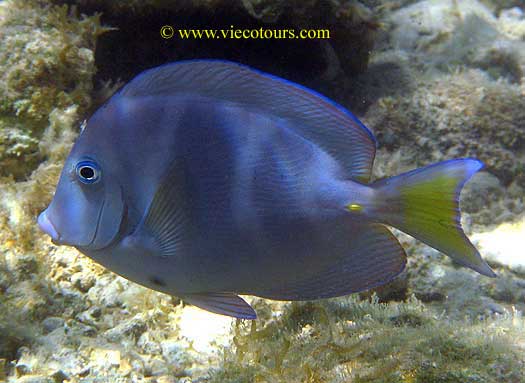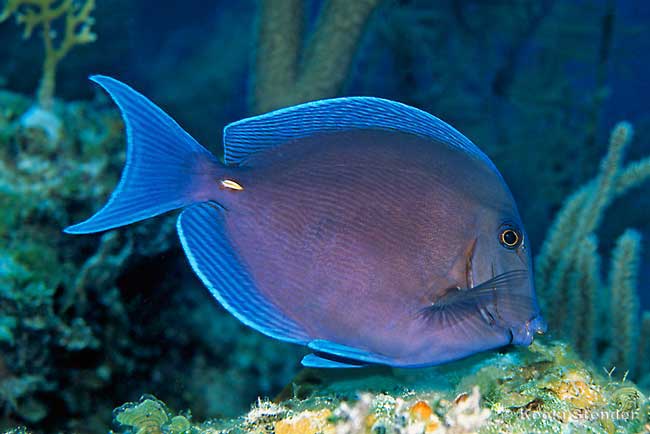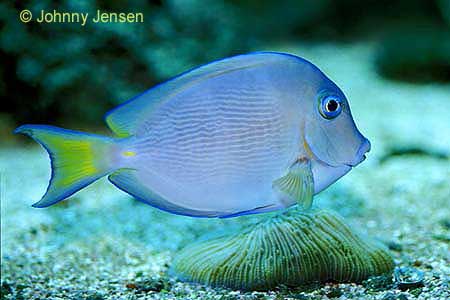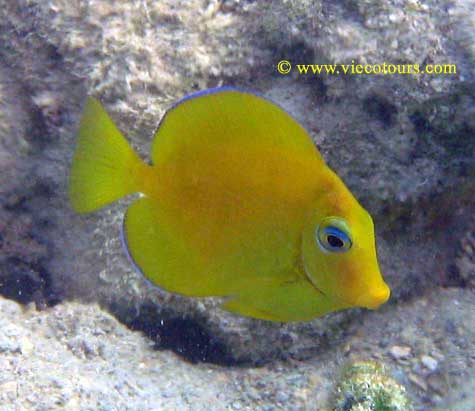|
|
Atlantic Blue Tang

The Atlantic Blue Tang is often referred to as the blue tang however this
confuses its name with the blue tang of the Pacific. The name blue tang is most
often used to refer to the Pacific Blue or
Regal Tang, however when you are in the
Caribbean the term always refers to its local inhabitant. The Atlantic Blue
Tang is also referred to as the Caribbean Tang, the Blue Barber, the Blue
Doctor, the Blue Doctorfish, the Blue Tang Surgeonfish, the Blur tang, the
Yellow Barber and Yellow Doctorfish. The references to yellow result
from the fact that juveniles are yellow in color.
The Atlantic Blue Tang is most common in the eastern Caribbean from Florida, through the Bahamas to as far south as Bermuda. It prefers coral reefs and
grassy areas and can be found in shallow waters or in depths up to 100 feet.
In corals, it will find shelter among the rocks and rest in crevices at night.
Atlantic Blue Tangs form pairs or small schools, sometimes running with other tangs.
Its shape is typical of tangs, with a laterally compressed body, a lengthy
continuous dorsal fin and a sharp retractable spine at the base of the tail.
The bright yellow juveniles are hard to find among the rocks. As they
mature, they transition to blue body with a yellow tail before turning
completely blue, except for a small yellow spot on the caudal peduncle.
There can be hints of orange in the tips of the fins. Intermediate
ages may also have horizontal grey streaking across the body. They
become sexually mature at about one year in age.

Atlantic Blue Tangs are exclusively
algae eaters in the wild, though they will eat meat in an aquarium setting.
It is preferable to stick with an algae diet to maintain good health. Good
choices are flakes foods based on veggies, seaweed and spirulina.Ê Dried seaweed can also be suspended in the tank with a veggie
clip.
Atlantic Blue Tangs will also each zucchini, broccoli and lettuce. The tank
should be at least 100 gallons. It should not contain other tangs.
Blue tangs are less likely to be aggressive with non tangs, however they can
still be very dominating in a tank.
Atlantic Blue Tangs breed in the evening and their eggs are pelagic – they float with
the tides after being fertilized. The eggs hatch within a day as silver /
brown slivers. They change to their tang appearance after about a week.
In the wild, tuna, jacks and groupers will feed on Atlantic Blue Tangs.


Juveniles are yellow
| Scientific Name: |
Acanthurus coeruleus |
| Family: |
Acanthuridae |
| Care: |
Normal |
| Temperature: |
22 - 26 C; 72 - 78 F |
| pH: |
8.1 - 8.4 |
| dH: |
8 - 12 |
| Specific Gravity: |
1.020 - 1.025 |
| Size: |
31 cm; 12 inches |
| Breeding: |
Egg Layer |
| Life Span: |
20 years |
| Crustacean Safe: |
Attacks small ones |
| Coral Safe: |
Yes |
|
Compatibility:
|
|
Other Atlantic Blue Tangs, yellow tangs, clownfish,
damsels, small angels (Centropyge), cardinalfish,
hawkfish
|
|